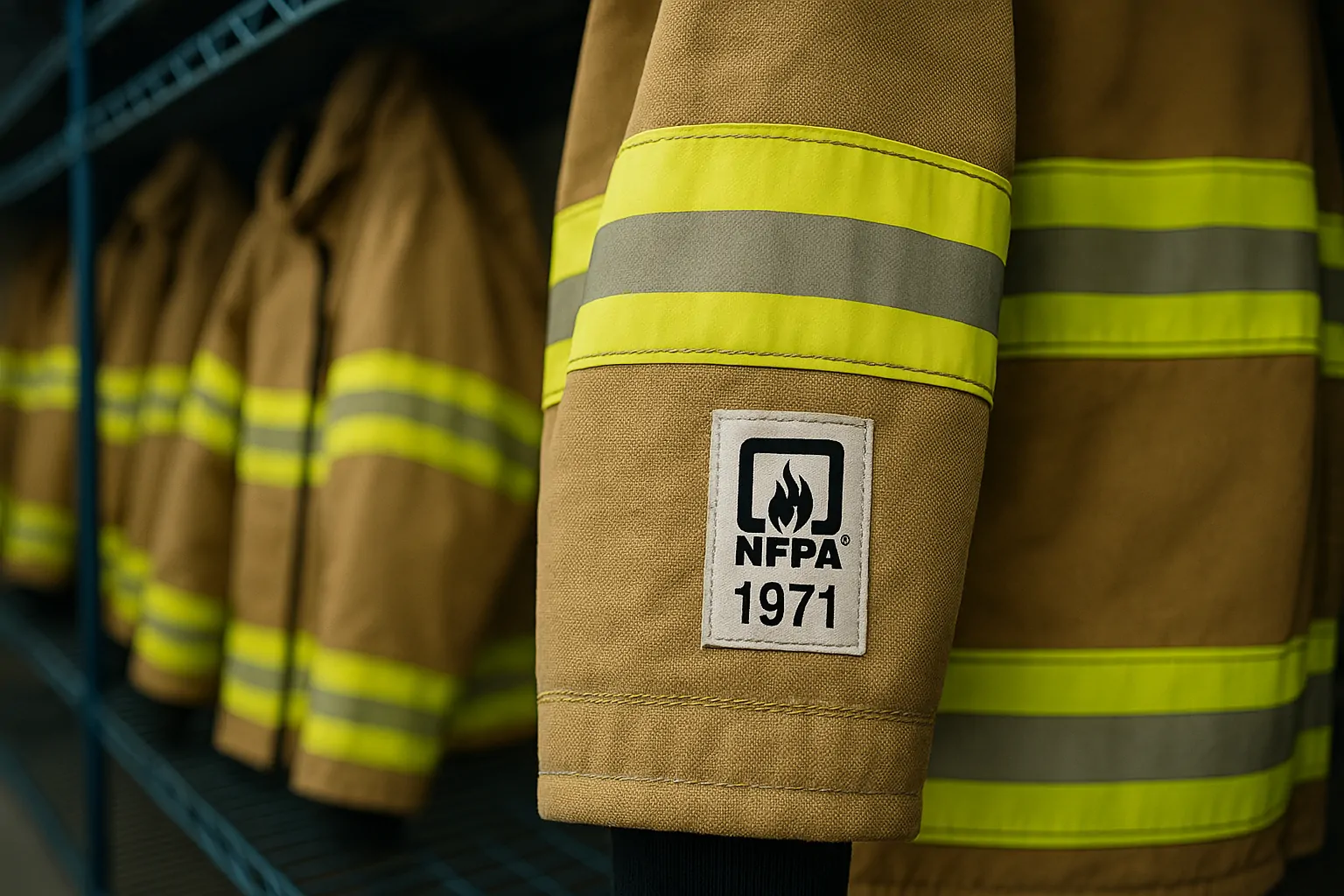In the unforgiving environment of a structural fire, when temperatures soar and visibility vanishes, firefighter safety depends on one thing above all else: their firefighter PPE. Properly certified and correctly worn, personal protective equipment (PPE) is not just gear—it’s life support.
Whether facing flashover, collapse risk, or toxic smoke, PPE serves as a critical barrier between life and death. According to the NFPA 1971 Standard on Protective Ensembles for Structural firefighting, turnout gear—including the outer shell, moisture barrier, and thermal liner—must meet strict performance benchmarks to provide effective thermal protection and limit heat stress.
Firefighters in the U.S. report over 25,000 fireground injuries annually, many of which could be mitigated by fully compliant PPE. Key components such as breathing apparatus (SCBA) and personal alert safety systems (PASS) further support firefighters protecting lives in dynamic, high-risk environments.
This article breaks down what protective clothing includes, how fire departments can ensure their equipment aligns with the NFPA 1971 standard, and why adherence is essential for reducing the risk to those who perform their duties on the front lines of the fire service.
PPE Standards in the U.S. Fire Service
In the United States, firefighter PPE is primarily regulated by the NFPA 1971 Standard on Protective Ensembles for Structural fire fighting, which serves as the foundation of firefighter safety across the country. However, components such as breathing apparatus (SCBA) and eye protection also follow additional standards from agencies like NIOSH, ANSI, and ASTM, ensuring full-spectrum protection and compliance.
Each element of the personal protective equipment (PPE) system must meet stringent performance and compatibility benchmarks. When issued as a complete set, the system must allow firefighters to perform their duties safely and effectively in structural fire conditions.

PPE Standards by Component
| PPE Component | Governing Standard | Purpose & Notes |
| Turnout gear (coat & pants) | NFPA 1971 Standard on Protective Ensembles for Structural | Specifies flame resistance, moisture barrier performance, and thermal liner insulation; ensemble certification required. |
| Helmet | NFPA 1971 | Protects against impact, radiant heat, and electrical hazards. |
| Gloves | NFPA 1971 | Provides cut, puncture, and thermal protection for the hands. |
| Boots | NFPA 1971 + ASTM F2413 | Covers toe impact, sole puncture resistance, and thermal durability. |
| Protective Hood | NFPA 1971 | Shields neck, ears, and jawline against heat stress and steam. |
| Eye Protection | ANSI Z87.1 + NFPA 1971 | Tested for impact resistance and SCBA compatibility. |
| Breathing Apparatus (SCBA) | NFPA 1981 + NIOSH 42 CFR Part 84 | Ensures air supply regulation, fire exposure resistance, and facepiece seal. |
| Personal Alert Safety Systems (PASS) | NFPA 1982 | Detects firefighter immobility and issues audible alarms in mayday conditions. |
Ensemble Certification

For consistent performance, NFPA 1971 mandates ensemble certification—testing all PPE components together to ensure interoperability. This prevents incompatibility between garments and gear and is critical for reducing the risk of PPE failure in active fireground scenarios.
All fire departments should obtain documentation from certified third-party labs (e.g., UL, Intertek) to verify full compliance. Products advertised as “NFPA-style” without certification should be avoided.
International PPE Standards Beyond the U.S.
While the NFPA 1971 Standard on Protective Ensembles for Structural Fire Fighting forms the foundation for firefighter PPE in the United States, fire services around the world rely on their own national standards—many of which reflect similar goals for thermal protection, durability, and operational safety, but differ in scope, test procedures, and certification pathways.
EN 469(Europe)
Issued by the European Committee for Standardization (CEN), EN 469 is the core standard for protective clothing used in structural fire operations across the EU. The standard measures performance across several categories:
Xf1/Xf2 – Flame spread resistance
Y1/Y2 – Water penetration resistance
Z1/Z2 – Water vapor resistance (breathability)
R1/R2 – Radiant heat performance
Each category uses a tiered system (Level 1 = basic, Level 2 = higher protection), allowing departments to choose PPE based on mission profile. Certified garments carry the CE mark and must comply with EU Regulation (EU) 2016/425. Compared to NFPA 1971, EN 469 puts greater emphasis on ergonomic comfort and breathability, while NFPA has higher thermal test thresholds.
AS/NZS 4967 & 4821(Australia / New Zealand)
AS/NZS 4967 outlines the requirements for structural firefighting ensembles, while AS/NZS 4821 applies to wildland and general purpose fire fighting. These standards emphasize:
Convective and radiant heat resistance
Thermal shrinkage limits
Mobility and comfort under high ambient temperatures
Unlike NFPA, which includes full ensemble testing, AS/NZS standards allow more modular certification. However, they are designed to address the specific risks posed by Australia’s extreme climate and wildfire exposure.
GA 10 & GA 634(China)
China’s firefighting PPE standards, such as GA 10-2014 (protective clothing) and GA 634-2015 (fire helmets), are issued by the Ministry of Public Security. While these standards are rooted in national fireground conditions and manufacturing systems, they increasingly reference test protocols from NFPA and EN frameworks.
Key focus areas include:
Flame resistance and tear strength
Seam strength and thermal insulation
Retroreflective striping and visibility in low light
China’s PPE is not automatically interchangeable with NFPA-compliant ensembles, but the gap is narrowing, especially among manufacturers seeking CE or NFPA dual certification for export.
Why Standards Matter in Firefighter PPE
Firefighter PPE standards exist for one reason: to save lives. Every requirement—from flame resistance to moisture protection—is based on real incidents where equipment failed, and firefighters got hurt.
Without clear standards like NFPA 1971, there’s no way to guarantee that a glove won’t melt, a hood will seal properly, or a breathing apparatus will hold up under heat. Compliance ensures PPE works together as a system, not just as individual parts.
Standards also protect departments. Agencies like OSHA and FEMA require NFPA-certified gear for legal compliance and grant eligibility. Using uncertified equipment can lead to liability, denied funding, or worse—loss of trust when it matters most.
Standards turn gear into protection, and protection into trust. Without certified, well-integrated PPE, even the best training can be undermined by equipment failure.
Whether you’re equipping a new recruit class, reviewing your department’s compliance, or preparing for your next AFG grant cycle, understanding firefighter PPE standards isn’t just helpful—it’s essential.
At Poseidon, we don’t just manufacture turnout gear—we build systems that meet NFPA, EN, and other global standards to keep firefighters safe in the moments that matter most. From structural fire to wildland operations, we offer fully certified solutions designed for real-world use.
Talk to one of our PPE specialists today to get tailored guidance, certification support, and mission-ready protection—built for the job, and backed by experience.

